Reliable Digitizing for Embroidery: Quick Turnaround
Reliable Digitizing for Embroidery: Quick Turnaround
Blog Article
Check Out Various Types of Embroidery Digitizing Techniques
Needlework digitizing has advanced substantially over the years, providing a myriad of strategies to bring layouts to life in the electronic world. The realm expands to more sophisticated techniques like photorealistic embroidery digitizing and the remarkable world of 3D embroidery digitizing.
Standard Hand Embroidery Digitizing
Typical hand embroidery digitizing entails the procedure of converting detailed hand-stitched layouts right into electronic styles for equipment needlework. This technique needs skilled craftsmens to carefully evaluate the handmade style and after that utilize specialized software program to recreate it in a digital format. Each stitch, color, and information must be meticulously converted to ensure that the significance of the initial hand needlework is preserved in the digital version.
Among the crucial difficulties of conventional hand needlework digitizing is recording the complexities and nuances of the handmade style. Digitizing for Embroidery. Artisans have to possess a deep understanding of different embroidery techniques, such as satin stitch, chain stitch, and French knots, to properly replicate these techniques in the digital realm. In addition, they need to have a keen eye for information to make sure that the digital layout maintains the very same degree of creativity and craftsmanship as the initial hand-stitched piece
Punching Technique
To perfectly shift from traditional hand needlework digitizing to the punching strategy, craftsmens need to now concentrate on converting the detailed digital styles into directions that embroidery devices can translate. The boxing technique includes using specialized software program to create digital files that have commands for the embroidery maker to comply with. This procedure requires a deep understanding of not just the design itself but additionally the capabilities and limitations of the embroidery machine.

Auto-Digitizing Software Application Programs
Embroidery digitizing has been reinvented by the introduction of auto-digitizing software program programs, supplying craftsmens with sophisticated tools to convert digital layouts into embroidery device guidelines read review successfully. Auto-digitizing software application utilize formulas to analyze digital pictures or vector documents and generate needlework designs immediately. These programs permit for quick and accurate conversion of intricate layouts into stitch patterns, conserving effort and time for embroiderers.
Among the vital advantages of auto-digitizing software program is its straightforward interface, making it available to both beginners and seasoned digitizers. These programs usually include attributes such as stitch modifying tools, thread color matching, and the ability to sneak peek the last embroidered style. Furthermore, auto-digitizing software program can take care of complex layouts with several colors and elaborate information, generating premium needlework documents ideal for different garments and fabric jobs.
While auto-digitizing software application uses convenience and efficiency, it is essential for customers to understand the restrictions of automated digitizing. Fine-tuning and hands-on changes might still be required to achieve additional resources the preferred needlework top quality, particularly when handling complex or one-of-a-kind styles. By leveraging the abilities of auto-digitizing software application alongside manual digitizing techniques, artisans can enhance their needlework digitizing process and produce stunning stitched pieces.
Photorealistic Embroidery Digitizing
Using sophisticated electronic imaging techniques, accomplishing photorealistic lead to needlework digitizing has actually come to be a popular skill among modern artisans. This method involves converting high-resolution images right into detailed stitch patterns that closely simulate the initial style, leading to embroidery items that exhibit natural detail and deepness.
To accomplish photorealistic needlework digitizing, craftsmens should have a keen eye for detail and a thorough understanding of exactly how various stitch types and thickness can influence the last outcome. By carefully mapping out each color and color in the picture, embroiderers can produce an electronic data that guides the needlework machine to duplicate the nuances of the original image accurately.
Photorealistic needlework digitizing is specifically popular in developing personalized designs for apparel, home style, and art items where catching the significance of a photograph or artwork is essential. This strategy enables craftsmens to transform memories, landscapes, portraits, and complex art work into stunning embroidered work of arts that showcase a mix of conventional workmanship and sophisticated technology.
3D Embroidery Digitizing
With the development of digital imaging strategies in attaining photorealistic cause needlework digitizing, the expedition of 'D Needlework Digitizing' uses a new measurement to the intricacies of layout duplication. 'D Embroidery Digitizing' describes the three-dimensional digitizing technique that includes deepness and structure to embroidery designs, developing a much more realistic and visually enticing final product. her latest blog This strategy uses software application that imitates the impact of light and shadow on the embroidery layout, improving its total visual impact.
Among the essential benefits of 'D Needlework Digitizing' is its ability to make layouts look more realistic and dynamic. By adding depth to the needlework layout, the end product appears much more realistic and exciting (Digitizing for Embroidery). Furthermore, this strategy enables for more innovative freedom in style execution, allowing embroiderers to try out various textures and results that were previously testing to achieve
Final Thought

Report this page